|
Collecting Beautiful Cigar Bands and Boxes
By Syl Turner
Posted July 2016

The use of the cigar band began in Cuba during the early part of the 19th century. Cuban cigars have always been recognized as the world’s best and as such, commanded a premium price. This price differential caused some unscrupulous European manufacturers to begin selling lower-grade cigars with Cuban names. To combat this practice, a Cuban cigar manufacturer by the name of Gustave Bock, a European immigrant to Cuba, began placing a paper ring containing his signature around all his cigars, and it wasn’t long before all Cuban manufacturers adopted this practice.
In the early 19th century, America cigar quality left much to be desired, and manufacturers, in competition with each other with the nickel cigars they produced, elected not to spend the money necessary for a band and for the labor to fashion it on the cigar. By the late 1880s, however, printing costs had been significantly reduced, and it wasn’t long before the U.S. cigar industry began employing the best lithographers, who by using ever-improving printing techniques, produced elegant cigar bands and cigar box labels.
|
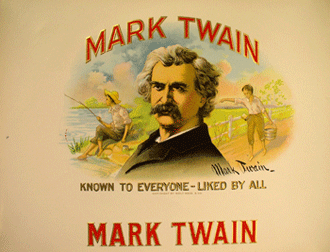
|
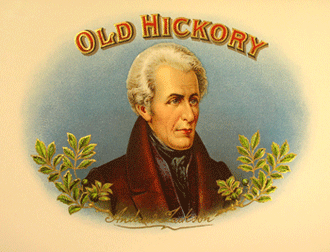
|
|
Mark Twain cigar box label, ca. 1930s, $15.
|
Old Hickory 1920s cigar box label, $20.
|
The adaption of cigar bands by U.S. producers created another opportunity for women to enter the cigar-making workforce. Bands were almost always applied by women using a dab of adhesive on the tip of their finger, being careful not to touch the cigar with the glue and being vigilant in arranging the band uniformly.
In 1900, an estimated four out of five men smoked cigars, and it wasn’t long before collecting cigar bands became a full-fledged obsession, with enterprising tobacconist selling albums for displaying the collected bands. Sometime around 1900, in an effort to dominate the cigar market, the American Cigar Co. introduced a program wherein one could earn premiums by exchanging cigar bands from their 28 different brands of cigars. As identified in their 1904 redemption catalogue: a young boy could obtain a football for 1,200 bands, and for 44,000 bands, a family could acquire a four-piece bedroom set.
|
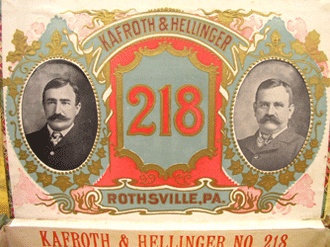
|
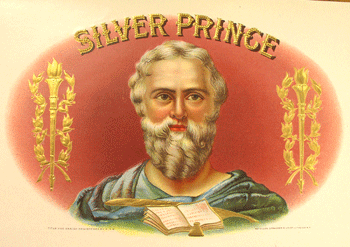
|
|
Kafroth and Hellinger wooden cigar box, ca. 1920, $45.
|
Silver Prince 1920s tobacco label, $10.
|
Antique collectors may recall seeing ashtrays decorated with cigar bands while browsing in antique malls. The use of cigar bands for decorating ashtrays, vases and other household items reached its peak in the first decade of the 19th century.
The first society of cigar band collectors was established in the United States in 1934, and some of the most avid devotees amassed collections of 200,000 or more. In the U.S. today, the number of collectors is relatively small and limited to true tobacco aficionados, ephemera collectors and people with artistic sensibility, who think of the bands as miniature works of art. Cigar band collecting is much more popular in Europe, but in our country, one can purchase on eBay, for example, a lot of 200 different vintage bands for as little as $10.
Cigar box and cigar box label collecting is a different story, in that they are widely collected for their beauty and historical interest. As might be expected, printing techniques and technological advancements in printing during the past 100 years are important factors in ascertaining the value and collectability of these labels.
Chromolithography was first used in the U.S. about 1840. Prior to this, color printing could only be produced by hand coloring black-and-white lithographs. Unlike lithograph printing which was produced from engravings, chromolithographs were printed from a flat surface. The process involved using a grease-based crayon to apply the image to a limestone slab called a stone. The stone was then covered with gum Arabic and a weak solution of nitric acid, inked with an oil-based ink, and passed through a press. A separate slab and a separate run through the press was necessary for each color in the print. Depending on the number of colors present, some labels required 20 or more slabs, taking months to prepare. This process allowed the use of heavy oil-based inks, including silver- and gold-colored inks, and the layering of inks from the use of multiple stones produced a texture and richness that make cigar label advertising so appealing to today’s collectors.
|
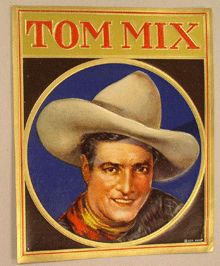
|
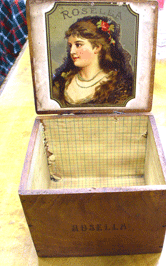
|
|
Tom Mix tobacco label, ca. 1930, $25.
|
Rosella cigar box, c. 1900, $49.
|
I chose the word advertising in depicting cigar labels because I think of these as early point-of-sale advertising. I can envision a storekeeper propping open the lids of cigar boxes for display on his store counter with the knowledge that these stunning images would entice sales.
Around 1875, technological advancements (photography with color filters) significantly reduced the labor and expense previously required to separate color, and by the mid-1880s, most American cigar companies were using chromolithograph labels.
The “Golden Age” for cigar label art was from the 1880s to the 1930s. During this period, there were more than 300,000 brands of cigars. By the mid-1930s, however, the Depression Era, coupled with the increasing popularity of the cigarette, had significantly reduced cigar sales, and a new print technology called 4-color offset printing began replacing chromolithography and the exceptional labels produced via that print process.
The value of a cigar label or cigar box depends on the usual factors: condition, subject matter, rarity and print process being the most important. When it comes to cigar label subject matter, nudes, Indians, sports, personalities and historical events are among the most sought after.
It should be noted that by 1940, chromolithography was all but nonexistent. Experienced collectors can easily distinguish a chromolithograph label from one printed from the 4-color offset print process, but for the novice collector who might be in doubt, the difference can easily be determined with a jeweler’s loupe. The chromolithograph will have small irregular dots caused by the grain in the stone, while the 4-color offset print will have a pattern of dots that are identical.
Most of the cigar box labels found in antique malls are common and can be purchased at prices ranging between $5 and $15. They are common only because they have been found in large quantities from cigar factories that have closed. However, these commonly found labels represent less than 10% of the hundreds of thousands of different labels that have been printed. On the upper end of the rarity scale, as much as 25% of all labels ever printed will fetch prices ranging from $250 to $1,500 and more. To get a better understanding of cigar label prices, visit the web site cigarlabelpriceguide.com which provides pictures and values for thousands of labels.
Approximating the age of a label can come from the printer’s identification, usually found in small print below the image. Some of the most valuable labels were manufactured by the German manufacturers Klingebburg Litho, identified by a “GK” mark, and Herman Schott, identified by an “H” with a dollar sign through it. An extensive list of American printers and the dates they were in business can be found with the Google search: “collecting cigar boxes and cigar label art eBay.”
One cannot talk about cigar labels without discussing the history and development of the boxes to which they were affixed. Before the appearance of the cigar box, which we are all familiar with, most cigars were sold in bundles of 50, tied together with a ribbon. The cigar box we know today came from the government’s desire to tax cigars to help fund the Civil War, and in 1863, Congress passed a revenue act that required such a tax. The problem was how to apply a tax stamp to a bundle from which individual cigars were sold and could unscrupulously be restocked to avoid taxation. The answer was to bundle the cigars into a box, nail it shut and apply a tax stamp over the lid, so when opened, the tax stamp would be broken.
Tax stamps were required on U.S. cigar boxes from 1863-1959, and their use helps identify the age of the box or container on which they were affixed. Here are some clues to the age of boxes you are likely to find:
*If the stamp is more than 12 inches, it is between 1878 and 1909.
*If the stamp is dated 1883, it is between 1883 and 1898.
*If the stamp is 8 inches long, it is between 1910 and 1915.
*If the stamp is 4 inches long and has no portrait, it is between 1916 and 1942.
*If the stamp is 4 inches ling with Henry Clay’s portrait, it is 1942 and 1959.
A Google search for the “Gotham Cigar Museum” will help date early Cuban boxes.
Collectors refer to the most common cigar box as “Nailed Wood” or NW. It consists of six pieces of wood, generally cedar, held together with 12 nails and a muslin hinge. It will hold 25 or 50 cigars. Almost all NW boxes produced after 1890 contained an interior lid label. The outside top of these lids could be branded and/or labeled. The value of NW boxes, with or without labels, is governed by rarity, condition, desirability of the label and country of origin. I included “country of origin” specifically for the antique Cuban boxes, which can be quite costly when found. A pre-1920 Cuban box in good condition, with all of the Cuban tax stamps, and with an interior label in good condition might sell for as much as $600.
The range in prices for antique wood cigar boxes from U.S. companies is huge. Pre-1930 boxes, in good condition and with ordinary labels, might be found at prices ranging from $50 to $150, depending on age and condition of the box and label. Similar boxes with better labels will command prices that are 30%-50% more than the label itself.
|
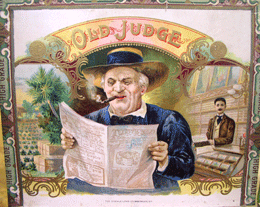
|
Old Judge cigar box, ca. 1910, $49.
|
A variation of the NW box is one in which metal hinges were used in place of the more common muslin cloth hinge. These boxes are referred to as “Nailed Wood with Hardware,” or NWH. Generally, these boxes did not have labels but used a steam-powered, hand-operated press to imprint images and ad copy directly onto the wood.
Wood boxes were not the only containers used in the retail sale of cigars. In 1870, a law was passed that allowed cigar boxes to be constructed of tin. These early tin boxes were hand-soldered and contained a paper label. They are very rare, as not many were produced. Tin cigar containers became more popular beginning in the 1920s and 1930s, but their use was more or less limited to a few manufacturers. Rarity of the brand and graphics on the tin are the principal factors in determining value, which might range from as little as $25 and up to several hundred dollars.
The first durable cardboard cigar box appeared in the 1950s, and by 1960, 75% of all domestically made cigars were packaged in cardboard. Cardboard boxes are generally not as desirable as the earlier WN boxes, due to age, construction material, and the quality of the printed label. With cardboard boxes, condition and subject matter of the label will determine their value.
In 1868, Congress passed a law requiring tax stamps on cigar boxes to be destroyed before being opened. Soon thereafter, the first cigar box opener was patented. In time, more than 100 different box openers were manufactured. (The last patent date for a cigar box opener was 1916.)
Although they differed in shapes and sizes, cigar box openers had some common features. They all had a tapered edge or a blade designed to slit the tax stamp and any label that might be pasted on the end of the box. Also, they all had a notch to pry open the nail that sealed the box, and most had a hammer-like head to pound the nail back in as might be necessary. Remember, this was before the use of humidified showcases, so it was normal that there might be a lot of opening and closing of a box.
In time, cigar manufacturers began imprinting their brand names on these openers for their salesmen to give to the cigar retailer. Unlike bottle openers that were often given free to the ultimate consumer, cigar box openers were designed and used almost exclusively by the cigar retailer. Today, they are widely collected with average prices in antique malls ranging from $10 to $25. However, like most collectibles, the rarest ones will command prices up to $100 or more. Very little has been written about cigar box openers, and most people when they see them do not recognize their function. Astute collectors see these seemingly unappreciated trinkets for what they are and are assembling large collections at very low prices.
Attempting to provide a more detailed coverage of cigar advertisements would have included for example: cigar cutters, cigar lighters, cigar ribbons, tin containers, trade cards, tin signs, posters, broadsides, pamphlets, matchbook covers, postcards, as well as a multitude of items with cigar brand identification.
---------------------------------
Syl Turner is the owner of The Broad Street Antique Mall in Chamblee, Ga. The antiques pictured are part of an important collection of tobacco collectibles he acquired. The entire collection of 500+ tobacco-related items is on display at the Broad Street Antique Mall from 10 a.m. to 5:30 p.m. Monday through Saturday and 1 p.m. to 5:30 p.m. on Sundays. The Broad Street Antique Mall is located 1.5 miles inside of Atlanta’s I-285, off Peachtree Industrial Blvd.
|